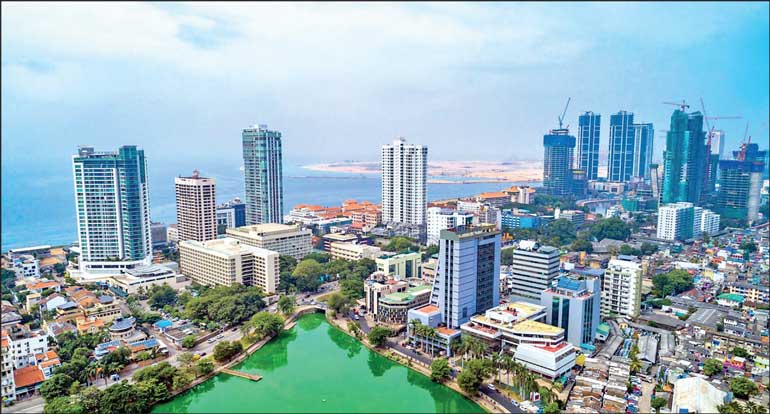Saturday Apr 19, 2025
Saturday Apr 19, 2025
Saturday, 21 December 2024 00:00 - - {{hitsCtrl.values.hits}}

To achieve lasting growth and better manage its debt, the country must implement critical structural reforms
 With a new Government in power, Sri Lanka finds itself grappling with immense economic challenges. The burden of enormous debts continues to weigh heavily on a fragile economy, necessitating robust growth to overcome these hardships. However, achieving such growth is complicated by a governmental predisposition toward centralised economic control, rooted in socialist-communal ideologies.
With a new Government in power, Sri Lanka finds itself grappling with immense economic challenges. The burden of enormous debts continues to weigh heavily on a fragile economy, necessitating robust growth to overcome these hardships. However, achieving such growth is complicated by a governmental predisposition toward centralised economic control, rooted in socialist-communal ideologies.
These challenges are not unique to Sri Lanka; they echo the historical pitfalls of centralised economic systems. This essay explores three illustrative examples from history: The failed socialism of the Plymouth Colony, the rapid recovery during the Forgotten Depression of 1920-1921, and the transformative innovation of the Gilded Age.
These examples are not often the subject of discussion by contemporary economists, but they offer valuable insights into the perils of excessive government control and the potential of free-market principles to foster prosperity.
The economy that failed: Plymouth Colony
The 17th-century settlers of Plymouth Colony experienced one of history’s earliest failures of socialism, nearly 200 years before Marx and Engels published the ‘Communist Manifesto’. When the pilgrims arrived in the New World in 1621, they established a socialist communal system where all resources were shared, and people worked according to their ability while receiving according to their needs.
Governor William Bradford documented the dire outcomes of this policy in his ‘History of Plymouth Plantation’. He described how the communal system caused “confusion and discontent” and discouraged effort. Young, able-bodied men resented working for other men’s families without recompense, and “the mutual respects that should be preserved amongst men” diminished. Women also resisted, disliking the expectation of doing hard labour for the community instead of their own households.
Even among the “godly and sober,” the system led to shortages and growing resentment. Theft of crops became common, and the colony endured years of famine and hardship, with half of the settlers dying. Bradford concluded, “Let none object this is men’s corruption.”
In 1623, Bradford made a significant change: Each household was given its own parcel of land, and families could keep or trade what they produced. This shift “made all hands very industrious,” resulting in much larger harvests than under the communal system. Women, who had previously claimed “weakness and inability,” now worked enthusiastically alongside their families in the fields, even involving their children, viewing labour as productive rather than oppressive.
Within a year, the colony had surplus harvests, and famine was eliminated. By 1624, Plymouth was exporting corn. Bradford noted that these changes brought “plenty” and ensured that “any general want or famine hath not been amongst them since to this day.” This historical event is commemorated in America on Thanksgiving Day.
Other early American colonies also tried socialist systems, with similarly poor results. At Jamestown, founded in 1607, fewer than half the settlers survived their first year. Most work was done by 20% of the men, while the other 80% avoided labour. During the winter of 1609–10, known as “The Starving Time,” the population fell from 500 to 60. When Jamestown adopted a free-market system, the results mirrored those of Plymouth—productivity and survival rates soared.
This transition from socialism to private property and market incentives illustrates a timeless principle: Productivity thrives when individuals have a direct stake in their work. The example of Plymouth Colony resonates even today, particularly in Sri Lanka, where state-owned enterprises based on communal systems often suffer from low productivity and inefficient use of resources. By adopting policies that limit the government’s role in the economy, Sri Lanka could potentially boost efficiency and address its ongoing economic challenges.
The Forgotten Depression of 1920-1921
The Forgotten Depression of 1920-1921, although rarely discussed, shows how a severe economic crisis can be resolved with minimal government intervention. Unlike the typical reliance on heavy intervention during downturns, this depression—marked by 12% unemployment, a sharp drop in industrial production, and a 17% decline in GNP—was swiftly addressed through fiscal discipline and market-based adjustments.
President Warren Harding rejected the advice of Vice President Herbert Hoover, who advocated for interventionist measures. Instead, Harding focused on shrinking the government. Federal spending was cut nearly in half between 1920 and 1922, and borrowing was reduced. He summarised this vision by stating:
“We will attempt intelligent and courageous deflation, and strike at government borrowing which enlarges the evil. We will endeavour to restrict government expenditure to the lowest possible amount consistent with the public welfare.”
In addition to these fiscal cuts, Harding reduced taxes, particularly for businesses and high-income earners, to encourage investment and entrepreneurship. The Federal Reserve also refrained from monetary expansion, allowing wages and prices to adjust naturally. This caused many unproductive businesses to go bankrupt, and was essential for stabilising the economy and facilitating a quick recovery.
By 1922, industrial output and employment levels had rebounded, surpassing pre-depression figures. This rapid recovery highlighted the effectiveness of a market-driven approach supported by prudent fiscal policies. Harding’s restraint laid the groundwork for a decade of economic prosperity known as the “Roaring Twenties.”
Harding’s approach relied on natural economic forces to adjust wages, prices, and investments, leading to a strong and fast recovery. This strategy was in stark contrast to the Great Depression of the 1930s, where interventionist policies prolonged economic hardship for a decade.
For Sri Lanka, the Forgotten Depression offers an important lesson: Excessive government spending and intervention often delay recovery. Instead, fiscal restraint and trust in market mechanisms can create a stable foundation for sustainable growth.
The Gilded Age: A model of growth and innovation
The Gilded Age in the United States (1860 to 1900) was a time of remarkable economic growth that has not been replicated since. During this period, the US transitioned from a farming-based economy to an industrial powerhouse. Innovations like railroads, electricity, telecommunications, and improved sanitation transformed industries and daily life. These achievements were made possible by limited government interference, which allowed human creativity to flourish.
While critics of the Gilded Age often highlight issues like inequality and poor labour conditions, the broader achievements of the time far outweighed these challenges. Worker productivity increased significantly, incomes rose, and millions experienced greater social mobility. Importantly, these advances occurred without many of the bureaucratic structures considered essential today.
Key features of the Gilded Age:
1.No central banking: The US followed the gold standard, which ensured stable money and low inflation. The economist Ludwig von Mises praised this system, saying it protected economies from reckless government spending and political influence over the money supply.
2. No income tax: The government operated without income taxes, funding essential infrastructure through tariffs and fees. This kept taxes simple and low, helping businesses thrive. Government spending accounted for less than 3% of GDP.
3. Limited role of Government: President Grover Cleveland epitomised this principle by vetoing a bill that would have provided seeds to struggling Texas farmers during a drought. In his veto message, Cleveland asserted:
“I do not believe that the power and duty of the General Government ought to be extended to the relief of individual suffering which is in no manner properly related to the public service or benefit. Though the people support the Government the Government should not support the people.”
Cleveland emphasised private charity instead. He argued that relying on federal aid weakens self-reliance, while acts of private generosity strengthen community bonds.
During the Gilded Age, US capital stock grew from $ 27 billion in 1869 to $ 165 billion by 1908. This dramatic growth fuelled increased productivity and wealth creation. Charities, mutual aid societies, and private initiatives played a significant role in supporting those in need, showing how civil society can address social challenges without extensive government intervention.
The Gilded Age demonstrates how free-market principles can drive innovation and prosperity, while at the same time providing social welfare. For Sri Lanka, the lesson is clear: Reducing Government control, welfare and subsidies, and creating an environment that encourages private involvement are essential steps for long-term economic growth and social welfare.
Javier Milei: A modern-day reformer
The principles of economic freedom and limited government are not just historical ideas. Argentina’s current president, Javier Milei, is putting these principles into action to address his country’s decades-long economic decline under socialism. His Libertarian philosophy focuses on reducing government size, cutting taxes, and abolishing the central bank—a bold but practical way to tackle inflation and restore financial stability.
Milei’s reforms include major budget cuts and reducing public sector jobs, showing his commitment to limiting the state’s role. He argues that central banks often worsen economic problems by printing money, which reduces currency value and purchasing power. By seeking to eliminate Argentina’s central bank, Milei aims to stabilise the economy and rebuild trust in its monetary system.
While some critics doubt the practicality of his policies, Milei’s initial efforts have generated hope. His approach reflects the lessons of Plymouth Colony, the Forgotten Depression, and the Gilded Age: Freeing individuals and businesses from excessive government control fosters economic growth. Sri Lanka can learn from Milei’s determination to tackle deep-rooted issues head-on and embrace bold reforms.
The road ahead for Sri Lanka
Sri Lanka’s economic challenges are significant but solvable. To achieve lasting growth and better manage its debt, the country must implement critical structural reforms:
nReassess the role of the Central Bank: Fixing prices—whether for goods or currency—leads to shortages and black markets. When the Central Bank controls exchange rates, interest rates, and prints money, it essentially fixes the price of money. This causes foreign currency shortages, inflation, and economic instability. By enabling Government overspending and corruption, the Central Bank becomes a root cause of many problems. Sri Lanka must review the Central Bank’s powers and consider whether its current role is sustainable. For a deeper analysis of these issues, Jörg Guido Hülsmann’s book The Ethics of Money Production is a useful resource.
nCut Government spending: The Government should prioritise fiscal discipline by eliminating unnecessary expenses, balancing the Budget, and reducing reliance on debt, taxes, and money printing.
nStreamline regulations: Complex regulations stifle innovation, encourage corruption, and deter investment. Simplifying these rules will empower businesses and attract foreign investors.
nReduce public sector jobs: Unlike private sector workers who produce goods and services, public sector employees are funded by taxpayers and do not always add value to the economy. Reducing unproductive Government jobs could ease demand pressures and help lower prices.
nProtect property rights: Strengthening private property protections, promoting privatisation, and simplifying taxes will reassure investors that their assets are secure. This can unlock Sri Lanka’s economic potential.
Recovery depends not on expanding Government control but on dismantling it. By implementing these reforms, Sri Lanka can create a resilient, market-driven economy that prioritises individual freedom and innovation over centralised control.
(The writer is a civil engineer based in Singapore. He can be reached on [email protected].)